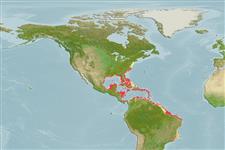Common names from other countries
Environment: milieu / climate zone / depth range / distribution range
Ökologie
seewasser riff-verbunden; standorttreu; tiefenbereich 2 - 60 m (Ref. 9626). Tropical; 22°C - 28°C; 44°N - 23°S, 98°W - 34°W
Western Atlantic: New England, USA to the vicinity of Rio de Janeiro, Brazil, including the Gulf of Mexico and the Caribbean (Ref. 26938).
Length at first maturity / Size / Gewicht / Alter
Maturity: Lm 22.6 range ? - ? cm
Max length : 60.0 cm TL Männchen/unbestimmt; (Ref. 3797); common length : 45.0 cm TL Männchen/unbestimmt; (Ref. 3797); max. veröff. Gewicht: 1.8 kg (Ref. 40637)
Rückenflossenstacheln (insgesamt) : 9; Rückenflossenweichstrahlen (insgesamt) : 31 - 33; Afterflossenstacheln: 3; Afterflossenweichstrahlen: 23 - 25. Pale gray around mouth, and pale gray margin on caudal fin. Inside of pectoral fin yellow (Ref. 26938). Juveniles are black with two light yellow bars on body and three on head; caudal fin yellow with a vertically elongate, nearly rectangular or hemispherical black spot in middle (Ref. 13442).
Maximum depth from Ref. 126840. Common in coral reefs, usually solitary, occasionally in pairs. Juveniles are part-time cleaners. Feed mainly on sponges, but also takes tunicates, algae, zoantharians, gorgonians, hydroids, bryozoans, and seagrasses. Oviparous (Ref. 240), monogamous (Ref. 52884). Flesh reported to be of excellent quality (Ref. 3797); marketed fresh and salted (Ref. 5217). Friendly toward divers (Ref. 9710). Have been reared in captivity (Ref. 35419).
Life cycle and mating behavior
Maturities | Fortpflanzung | Spawnings | Egg(s) | Fecundities | Larven
Monogamous mating is observed as both facultative and social (Ref. 52884).
Allen, G.R., 1985. Butterfly and angelfishes of the world. Vol. 2. 3rd edit. in English. Mergus Publishers, Melle, Germany. (Ref. 4858)
IUCN Rote Liste Status (Ref. 130435)
CITES (Ref. 128078)
Not Evaluated
Bedrohung für Menschen
Reports of ciguatera poisoning (Ref. 30303)
Nutzung durch Menschen
Fischereien: weniger kommerziell; Aquarium: Kommerziell
Tools
Zusatzinformationen
Download XML
Internet Quellen
Estimates based on models
Preferred temperature (Ref.
115969): 23.8 - 28.1, mean 27.3 (based on 849 cells).
Phylogenetic diversity index (Ref.
82804): PD
50 = 0.5001 [Uniqueness, from 0.5 = low to 2.0 = high].
Bayesian length-weight: a=0.03236 (0.01644 - 0.06368), b=2.90 (2.73 - 3.07), in cm Total Length, based on LWR estimates for this species & Genus-body shape (Ref.
93245).
Trophic level (Ref.
69278): 3.2 ±0.1 se; based on diet studies.
Widerstandsfähigkeit (Ref.
120179): sehr niedrig, Verdopplung der Population dauert mehr als 14 Jahre. (Preliminary K or Fecundity.).
Fishing Vulnerability (Ref.
59153): Moderate vulnerability (44 of 100).
